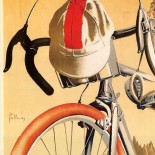Military Cycling: The Volunteer Easter Manoeuvres, 1888
Unlike the successful Easter Manoeuvres of 1887 that had seen the bicycle prove its worth in a military context the cyclists in the 1888 Manoeuvres weren’t blessed with the same good weather and roads, nor it seems with good riders. Things had got off to a bad start as Colonel A. R. Savile’s cyclist Corps left Guildford to cover the ten miles to Farnham. Heavy rain and sticky roads impeded progress and the cyclists showed little aptitude for marching in order, the 26th Middlesex somehow managing to lose a man into the bargain. To add insult to injury their much vaunted Maxim gun mounted on a three man multi-cycle proved unmanageable in the conditions and had to be abandoned. In similar vein the Bristol Engineers wrecked their ‘flying sapper’, another multi-cycle, before they’d covered five miles. This after being up all night repairing it after breaking it on the previous day.
At times the ninety man column had been stretched out for nearly a mile with the advance guard not only out of sight, but out of touch with the main body. Savile, realising that the force would not reach Salisbury in time at their present rate then took the decision to entrain the men and their bicycles at Farnham and despatch them to Winchester. By the time the cyclists had reached Winchester the weather had taken a turn for the worse and they set off to cover the twenty-two miles to Salisbury in the face of heavy rain and high winds.
By Stockbridge, some eight to nine miles down the road, Savile had lost nearly forty men, and it took the column nearly five hours to reach the Pheasant Inn near Salisbury where the stragglers finally closed up with the head of the column.
Having regrouped, the column then advanced on the enemy position, unknowingly being observed all the while by the enemies cycling scouts who made their getaway unseen as Savile’s column approached their position.
It had been a difficult day for Savile and his men. Many roads had been so bad that they had been forced to push or carry their bicycles uphill. In addition to the loss of the Maxim and the ‘flying sapper’ machines there had been numerous mechanical breakdowns, including Savile’s cycle and no less than three bicycles ridden by Lieutenant Bruno Holmes. One imagines that they were a tired, wet, and frustrated body of men as they took their quarters for the night.
The remainder of the manoeuvres were little better. On the following day Savile’s cyclists, now playing the part of the invading enemy advanced on Houghton Down along the sky line only becoming aware of the defending force when it opened ‘fire’ upon them. In a scene reminiscent of the Charge of the Light Brigade the 26 Middlesex charged downhill on their bicycles into a deadly ‘fire’ at two hundred and fifty yards range only to remember on reaching the bottom that their rifles were still securely stowed on their machines. Unslinging them would have taken crucial moments and the umpires declared them out of action and sent them to the rear.
Further skirmishes between rival detachments of cyclists demonstrated that a rear guard of cyclists could delay an advancing body of cyclists by compelling them to dismount under fire and deploy thus drawing them away from their machines. The rear guard could then retire with their cycles leaving the advancing troops to return to their bicycles and advance over the same ground only to face the rear guard once again.
The final stage of the manoeuvres, a ride from Guildford to Dover intended as a demonstration of moving a body of cyclists proved little. The men were allowed to make the journey as they chose, with some opting to ride the distance, and others taking any available train and on different railway lines. Important equipment was also left behind. The finale took place on Easter Monday when the Corps rode into Dover and were given the head of the line in the march past the Commander-in-Chief, who praised their appearance and their performance on the ride from Guildford to Dover, arguably the least important part of the manoeuvres.
In fact none of Colonel Savile’s schemes had been successful, except in the sense that the cyclist Corps had again demonstrated that troops mounted on bicycles could march more quickly than infantry, and at least as quickly as cavalry, even in bad weather and on bad roads. The bicycle as a mobile gun platform had proved a failure, as did the Bristol Engineers attempt at using a multi-cycle to transport more than one man on a single machine. Tactically the Corps had been inept and had demonstrated no advantage over cavalry or infantry in combat. And significantly the manoeuvres had highlighted the lack of training in the volunteer forces.
We should temper this criticism by recognising that 1888 represented only the second official use of cyclists in the manoeuvres, with their first appearance occurring in 1885 only as a result of cavalry not being available to the 1st Volunteer Battalion Royal Sussex Regiment. Subsequent years were to see a wide ranging discussion as to the proper use of cyclists, the equipment they needed, the bicycles they should ride, the tactics they employed, and the drills and training they should undergo that led to a series of manuals published in the first decades of the Twentieth Century.







Fascinating. Always finding something interesting Aaron. Well done!
LikeLiked by 1 person
Cheers Robert. I have access to the aforementioned drill manuals so more to follow on this theme
LikeLiked by 1 person